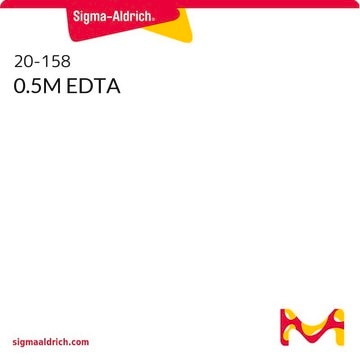If this product has an expiration or retest date, it will be shown on the Certificate of Analysis (COA, CofA). If there is no retest or expiration date listed on the product's COA, we do not have suitable stability data to determine a shelf life. For these products, the only date on the COA will be the release date; a retest, expiration, or use-by-date will not be displayed.
For all products, we recommend handling per defined conditions as printed in our product literature and website product descriptions. We recommend that products should be routinely inspected by customers to ensure they perform as expected.
For products without retest or expiration dates, our standard warranty of 1 year from the date of shipment is applicable.
For more information, please refer to the Product Dating Information document: https://www.sigmaaldrich.com/deepweb/assets/sigmaaldrich/marketing/global/documents/449/386/product-dating-information-mk.pdf
E7889
Ethylenediaminetetraacetic acid disodium salt solution
for molecular biology, 0.5 M in H2O, DNase, RNase, NICKase and protease, none detected
Synonym(s):
(Ethylenedinitrilo)tetraacetic acid disodium salt, EDTA disodium salt, EDTA-Na2
About This Item
Recommended Products
grade
for molecular biology
Quality Level
sterility
0.2 μm filtered
form
liquid
reaction suitability
reagent type: chelator
concentration
0.5 M in H2O
pH
7.5-8.5
suitability
suitable for molecular biology
application(s)
microbiology
foreign activity
DNase, RNase, NICKase and protease, none detected
SMILES string
[Na+].[Na+].OC(=O)CN(CCN(CC(O)=O)CC([O-])=O)CC([O-])=O
InChI
1S/C10H16N2O8.2Na/c13-7(14)3-11(4-8(15)16)1-2-12(5-9(17)18)6-10(19)20;;/h1-6H2,(H,13,14)(H,15,16)(H,17,18)(H,19,20);;/q;2*+1/p-2
InChI key
ZGTMUACCHSMWAC-UHFFFAOYSA-L
Looking for similar products? Visit Product Comparison Guide
Related Categories
General description
Application
- in Tris hydrochloric acid (HCl) for digesting proteinase-K to determine the amount of DNA in the corneal sample
- with papain to digest corneal samples for the quantification of glycosaminoglycan (GAG) content
- in pretreatment for detaching epithelial cells grown to 80% confluency
- to prepare stock solutions for lysis buffer
- in the preparation of urea lysis buffer
Features and Benefits
Preparation Note
Other Notes
comparable product
Signal Word
Warning
Hazard Statements
Precautionary Statements
Hazard Classifications
STOT RE 2 Inhalation
Target Organs
Respiratory Tract
Storage Class Code
12 - Non Combustible Liquids
WGK
WGK 2
Flash Point(F)
Not applicable
Flash Point(C)
Not applicable
Choose from one of the most recent versions:
Certificates of Analysis (COA)
Don't see the Right Version?
If you require a particular version, you can look up a specific certificate by the Lot or Batch number.
Already Own This Product?
Find documentation for the products that you have recently purchased in the Document Library.
Customers Also Viewed
Articles
ReadyShield® phosphatase and protease inhibitor cocktail FAQ for sample protection in a variety of cell types and tissue extracts, including mammalian, plant, and microbial samples. Our ReadyShield® Protease Inhibitor Cocktail is a non-freezing solution that contains inhibitors with a broad specificity for serine, cysteine, acid proteases and aminopeptidases.
ReadyShield® phosphatase and protease inhibitor cocktail FAQ for sample protection in a variety of cell types and tissue extracts, including mammalian, plant, and microbial samples. Our ReadyShield® Protease Inhibitor Cocktail is a non-freezing solution that contains inhibitors with a broad specificity for serine, cysteine, acid proteases and aminopeptidases.
ReadyShield® phosphatase and protease inhibitor cocktail FAQ for sample protection in a variety of cell types and tissue extracts, including mammalian, plant, and microbial samples. Our ReadyShield® Protease Inhibitor Cocktail is a non-freezing solution that contains inhibitors with a broad specificity for serine, cysteine, acid proteases and aminopeptidases.
ReadyShield® phosphatase and protease inhibitor cocktail FAQ for sample protection in a variety of cell types and tissue extracts, including mammalian, plant, and microbial samples. Our ReadyShield® Protease Inhibitor Cocktail is a non-freezing solution that contains inhibitors with a broad specificity for serine, cysteine, acid proteases and aminopeptidases.
Protocols
Preparation of Plasmid DNA by Alkaline Lysis with SDS: Maxipreparation between Cold Spring Harbor Laboratory Press and our research team.
-
How can I determine the shelf life / expiration / retest date of this product?
1 answer-
Helpful?
-
-
How is shipping temperature determined? And how is it related to the product storage temperature?
1 answer-
Products may be shipped at a different temperature than the recommended long-term storage temperature. If the product quality is sensitive to short-term exposure to conditions other than the recommended long-term storage, it will be shipped on wet or dry-ice. If the product quality is NOT affected by short-term exposure to conditions other than the recommended long-term storage, it will be shipped at ambient temperature. As shipping routes are configured for minimum transit times, shipping at ambient temperature helps control shipping costs for our customers. For more information, please refer to the Storage and Transport Conditions document: https://www.sigmaaldrich.com/deepweb/assets/sigmaaldrich/marketing/global/documents/316/622/storage-transport-conditions-mk.pdf
Helpful?
-
-
How many divalent cations does Product E7889, EDTA disodium salt, complex with?
1 answer-
EDTA forms 1:1 complex with divalent cations.
Helpful?
-
-
What is the Department of Transportation shipping information for this product?
1 answer-
Transportation information can be found in Section 14 of the product's (M)SDS.To access the shipping information for this material, use the link on the product detail page for the product.
Helpful?
-
-
Can a solution of EDTA disodium salt, Product E7889, be autoclaved?
1 answer-
Yes, solutions of EDTA may be autoclaved.
Helpful?
-
-
What is the pH of E7889, EDTA disodium salt solution?
1 answer-
E7889 has a pH specification of 7.5 to 8.5 at 25 °C.
Helpful?
-
-
At what concentration should I use Product E7889, EDTA disodium salt, as an anticoagulant?
1 answer-
The optimal concentration of EDTA to be used as an anticoagulant is 1.5 mg of EDTA disodium salt per ml of blood or 1-2 drops of a 2% EDTA solution per ml of blood.
Helpful?
-
-
What type of biological activity does Product E7889, EDTA disodium salt, exhibit?
1 answer-
EDTA is a metal ion-dependent enzyme inhibitor. It may be used as a metalloprotease inhibitor at a concentration of 1-10 μm, or as a DNAse I inhibitor at a concentration of 1-10 mM.
Helpful?
-
Active Filters
Our team of scientists has experience in all areas of research including Life Science, Material Science, Chemical Synthesis, Chromatography, Analytical and many others.
Contact Technical Service





